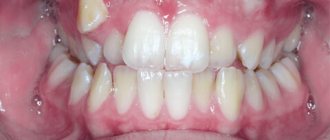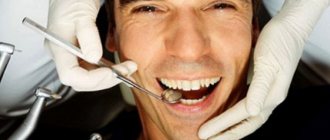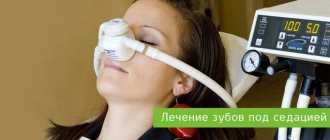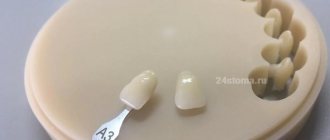On each side of the adult jaw there are several types of teeth: two front ones, called incisors, one eye - a canine, and two premolars and molars. Teeth of one type differ from another not only in functionality and appearance, but also in structure. The weakest are the incisors, which are responsible for biting, tearing food and are not adapted for chewing it, and the strongest are the fangs located behind them in the corners of the jaws.
Each of the fangs has a powerful root and an elongated crown. Premolars, responsible for chewing food, are distinguished by a wide chewing surface with two tubercles. And the chewing surface of the molars, which grind food, is equipped with 4–5 tubercles. Anomalies requiring orthodontic intervention and, in particular, treatment with braces most often occur on the eye teeth.
Dystopic wisdom tooth: what is it?
A dystopic wisdom tooth is a third molar, also known as a “figure eight”, which is positioned incorrectly relative to the rest of the dentition. Such a tooth almost always needs to be removed.
A special case of a dystopic wisdom tooth is an unerupted, but fully formed figure eight, which turns out to be turned parallel to the gum. In this case, the tooth is there, although it is not visible, and it is in an incorrect position, so we can talk about dystopia.
Two examples of dental dystopia
Causes of dystopic wisdom teeth
Very often, dental dystopia is associated with genetic reasons. A predisposition to shifting dentition is inherited along with small jaw size and other aspects of individual appearance that can cause teeth to shift. Doctors call other factors that provoke improper growth of molars, incisors and fangs:
- atypical formation of the tooth germ in the embryonic period;
- macrodentia, partial adentia, supernumerary teeth and other diseases;
- improper eruption (can be caused by early removal of the primary bite);
- small jaw size;
- mechanical damage, dental trauma;
- bad habits such as chewing foreign objects, thumb sucking (affect the development of malocclusion);
- late eruption of canines, for which there is no longer room in the dentition.
Modern dentistry successfully cures the patient, regardless of the causes of tooth dystopia and its position in the gum. The main thing is to seek help in time.
Why canine teeth often grow crooked or do not erupt completely?
For most children, “threes” are the very last to appear - closer to ten or twelve years. Because of this, it may turn out that there is no place for them. Then they begin to grow higher than necessary, behind or in front of their neighbors.
Another common problem with crooked eye units is the discrepancy between the size of the teeth and the width of the jaw. This phenomenon is quite common - a child may inherit a small jaw from one parent, but large, large teeth from the other.
The third cause of dental anomaly is the delayed replacement of milk units with permanent ones. There is no way to influence her. You just have to eliminate the consequences of deviation.
Types of wisdom teeth dystopia
Wisdom tooth dystopia is classified depending on which direction the crown is shifted. The following types of disease are distinguished:
- vestibular (forward displacement);
- oral (teeth located behind the entire row);
- mesial (forward bend);
- distal (backward tilt);
- with supraposition (above the dentition);
- with infraposition (below the dentition);
- with tortoposition (the tooth is rotated around its axis);
- with transposition (the tooth is in the place of another tooth).
In the most severe cases, you can observe the appearance of a tooth outside the oral cavity: for example, inside the nose. This is very dangerous and requires immediate treatment.
How to straighten a child's teeth
In modern orthopedic dentistry, several methods are used to correct dental anomalies in children. You should contact an orthodontist at the age of 3-4 years. The doctor will be able to recognize abnormalities if they exist. An abnormal bite is treated by keeping the teeth in the correct position.
Braces are often used for correction. Special orthodontic locks are glued to the enamel surface and secured with an arch. They gradually shift the dentition into the correct position.
Also used:
- Trainers are the most gentle method, they are made of silicone and are put on both jaws. If you use trainers daily, the treatment period is up to 1.5 years;
- plates that correct bite - there are removable and non-removable plates; they are made of plastic with metal wire inserts; removable structures can be removed during meals and oral hygiene.
During the consultation, the orthodontist determines the possibility of straightening without braces. Alternative methods can be used when the patient is allergic to metal, when the gums are low, the whole row is not curved, that is, only 1-2 teeth are incorrectly positioned. Aligners cope with almost all occlusion defects. They allow treatment to be carried out comfortably and quickly.
Symptoms of dystopia
Symptoms of dental dystopia are most often visual and easily noticeable. It is enough to look at the position of all the elements of the dentition to see that some of them are in the wrong places or are simply growing unevenly. Other symptoms:
- there is no tooth in the bite, and the period of eruption has already passed;
- inflammation and pain are felt at the site of the wisdom tooth;
- The wisdom tooth did not appear on time
It is interesting that in a number of cases there is no wisdom tooth at all - it does not form and does not erupt. Dentists call this option a variation of the norm.
Consequences of dystopia
Although dental dystopia does not seem like a terrible disease, it can create many problems. This is why wisdom teeth that have grown incorrectly are most often removed. Among the most unpleasant consequences of the disease:
- disruption of the entire dentition, because due to one incorrect element, the rest move or cannot erupt correctly;
- injury to the tissues of the cheeks, tongue, lips, which can cause ulcers and even provoke the development of tumors;
- complication of oral hygiene, which leads to inflammation, caries, both on the dystopic and adjacent teeth;
- the appearance of gingival pockets where bacteria accumulate, leading to pericoronitis;
- impaired chewing function, which in turn reduces the quality of food and can lead to deterioration of the gastrointestinal tract;
- difficulty pronouncing words, poor diction;
- violation of the facial skeleton, unaesthetic appearance of the lower part of the face.
Almost always, dystopia leads to unpleasant aesthetic consequences, which causes complexes and rejection of one’s appearance in the child, and then in the adult. Of course, this can be worked out with a psychologist, but it is much wiser and more correct to deal with the cause than to deal with the consequences.
How to straighten teeth without braces
Patients are often reluctant to get braces due to the long treatment period and the visual appeal of iron clasps. Bite correction using aligners has become a very popular procedure.
Aligners are trays made of transparent and elastic material that are applied to the entire dentition. The patient can take them off and put them on independently. The principle of their influence is imperceptible, gradual pressure on the teeth. This points them in the right direction. The material does not injure the gums, mucous membranes, enamel, and does not cause allergies.
At a consultation appointment at the Propricus clinic, the doctor will tell you in detail about this treatment. During the entire treatment period, the patient is given several sets of mouth guards. Aligners are prescribed if crowding or large gaps are diagnosed, if the jaw moves forward.
Before correcting a crooked tooth with mouth guards, you also need to sanitize your mouth. The aligners themselves can be cleaned with toothpaste and a toothbrush. There are no food restrictions. The only thing is that you need to remove the aligners before eating and then rinse your mouth.
Diagnosis of dystopia
An orthodontist or even a dental therapist can easily determine tooth dystopia during a routine examination if the anomaly is not complex. In some cases, when an element of the dentition remains in the gum, ends up in the palate or another place, during the examination one can only suspect a problem.
If the doctor has not found one of the teeth that should have already erupted in a child (or an adult, if we are talking about eights), he will refer the patient for an x-ray examination. The picture clearly shows all the irregularities and you can see the formed teeth in the soft tissues. To clarify the position and for subsequent treatment, arthopantomography, creation of plaster models of the jaws, and teleradiography are used.
Braces for fangs
If we consider all possible anomalies of the dentition, then most often it is the fangs that are crooked. According to statistics, every third orthodontic patient wants to correct the position of the “eye” teeth. Among the possible options for their dystopia:
- noticeable protrusion from the jaws (like a vampire);
- excessive or, conversely, insufficient crown length;
- closure by adjacent units located in front;
- incomplete eruption;
- turning in any direction at the wrong angle.
The “vampire smile” not only looks strange and unaesthetic, but also prevents complete chewing of food, and this negatively affects the functioning of the gastrointestinal tract. Therefore, it is imperative to solve the problem of curvature.
When is the best time to treat dental dystopia?
Like any dental disorder, dystopia should be treated immediately after the problem is discovered. The easiest time to change the position of teeth is during childhood and adolescence (up to about 18 years of age). This is due to the time of formation of the jaw bones. Until adulthood, the bone is still quite soft, which makes it easy to align the bite.
Sometimes, although rarely, trainers are used to treat dystopia. Read more about them in the article: Trainers for teeth straightening: description, varieties, tips for use
If we are talking about dystopic molars , then they are almost always removed. The third molars themselves are considered an atavism and an optional element in the dentition; moreover, their treatment is associated with problems and difficulties. Therefore, doctors do not try to save these teeth.
Sometimes treatment is associated not with removal, but with grinding of the tooth. This decision is made if the dystopic element does not interfere with the chewing function and does not violate the aesthetics of the oral cavity. In this case, it is recommended to be constantly monitored by a doctor, since such elements of the dentition are easily affected by caries. Moreover, the consequences are much more serious than in ordinary cases: incorrect tooth position stimulates the development of bacteria, inflammation, and complications.
Installation of braces for the treatment of canine dystopia
What is retention
Retention is a delay in the growth of baby or molar teeth. With this pathology, the tooth may erupt, but not completely, but can be barely visible above the gum, and it can also grow only under the gum, not showing out at all. First of all, this disease affects the second premolars and third molars located on the lower jaw, as well as the canines of the upper jaw. Maxillary canine impaction is much more common in women. This pathology can occur on one side of the jaw or on both sides at once. Canine impaction in the lower jaw is a very rare occurrence. Impaction of primary teeth is also extremely rare. Such disorders in children can be caused by an acute lack of vitamins in the body or serious pathologies during teething. Impaction of primary teeth can be caused by severe rickets.
Removal of dystopic wisdom tooth
Removing a dystopic wisdom tooth is a fairly serious operation that requires professionalism and care from the doctor. Incorrect actions can lead to dislocation of adjacent teeth, lower jaw, injury to the mandibular canal and other problems. Therefore, it is very important to contact experienced specialists who are familiar with the specifics of removing complex teeth.
Indications for removing a dystopic tooth
Clear indications for removal:
- detection of a jaw cyst;
- traumatic dystopia;
- diseases of the jaw caused by this tooth;
- difficulties in treating caries in adjacent teeth;
- the appearance of pulpitis and periodontitis.
The practice is that the decision to remove a child is made taking into account all these factors. In an adult, it is more likely to decide whether to keep a tooth or not – removal is considered a universal solution, the simplest and safest. They resort to it in almost all cases.
Stages of removing a dystopic wisdom tooth
The removal operation is carried out in several stages. Compliance with technology allows you to protect the patient and simplify the operation for the doctor. Also, before starting work, detailed studies must be carried out: a full x-ray of the jaw is taken, all available caries is cured, etc.
During tooth extraction, the surgeon performs the following actions:
- Introduction of anesthetic. This may be local anesthesia or general anesthesia if several teeth are to be removed at once.
- Complete exposure of the tooth. To do this, a flap of mucous membrane and periosteum are peeled off.
- I sawed off the walls using a drill. This is necessary to align the element and make it easier to remove.
- Tooth extraction. The entire molar is removed using forceps. If the tooth was previously destroyed, its fragments are removed. It is important that the doctor removes all the fragments, otherwise inflammation will occur.
- Application of antiseptics to prevent the development of wound infection.
- Returning the mucosal flap to its place.
- Applying seams.
Once the wound is stitched, the operation is over, but the treatment is not. After a week, you should definitely see a doctor to have the stitches removed. It is also advisable to be observed by a specialist for 1-2 months to make sure that the removal had no consequences.
Removal of a dystopic tooth in pictures
Elimination of anomaly
Treatment of retention is a rather complex process that requires qualified assistance from dentists of several specializations. Treatment is selected individually for each patient and depends on the clinical picture of the oral cavity. The first question that a dentist needs to decide is whether to remove or save a diseased tooth. There are several treatment methods, most often this is a surgical intervention in which a specialist cuts the gingival hood so that nothing prevents the tooth from erupting outward. Surgical procedures of this kind are used in situations where the tooth grows correctly and does not interfere with neighboring teeth. In other cases, most often, the tooth is removed. Removing an impacted tooth is a rather difficult operation. The procedure is carried out under local anesthesia, after which the gum is cut, and the specialist uses a bur to create access to the tooth, after which it is completely removed. Then a special medicine is placed into the tooth socket. If necessary, sutures are applied and removed ten days after the procedure. Swelling may occur after removal of an impacted tooth. Most often, after removing such a tooth, the doctor prescribes antibiotics and painkillers. Also, the patient, for the first few days, needs to stop eating solid foods, hot and cold foods and drinks.
Forecast of dystopia
The appearance of a dystopic tooth in a child is not such a serious problem (especially if there is only one). Before a person’s facial skeleton stops growing, the position of the main teeth can be normalized quite quickly. Therefore, it is recommended to begin treatment immediately after identifying the problem. In this case, all the teeth will most likely fall into place and in the future, in adulthood, will no longer cause concern.
If correction of dystopia in an adult is required, this almost always causes many difficulties. After 18-20 years, teeth are no longer so mobile, so correcting their position requires many preparatory interventions. It is much easier to remove a problematic tooth than to try to put it back in place.
Being cured in a timely manner, dystopia has virtually no negative impact on a person’s future life. Most often, the correct bite is maintained for a long time and does not require supervision by a doctor.
Correction of crooked teeth - where to go?
A distinctive feature of Amazing Price Dentistry is an individual and comprehensive approach. During dental treatment, these problems as a whole are taken into account, not focusing only on its immediate solution, but on eliminating the cause. A holistic approach is provided by a multidisciplinary team of experts representing specific areas of dentistry, ensuring the best possible results. Teamwork and multidisciplinary consultations significantly reduce the risk of unwanted complications during treatment, and careful planning makes the process clear and transparent for the patient. If you are looking for a clinic that provides treatment in accordance with the highest international standards, we are waiting for you at any convenient time.
Do you have crooked teeth? What to do? – experienced Moscow specialists at Amazing Price Dentistry know. Make an appointment by phone, and dentistry together with the patient will find a solution that suits you in terms of execution time, effect and price.
Author:
Mayorov Andrey Mikhailovich
Specialization:
orthopedic dentistry, dental prosthetics, implant installation
Prevention of dystopia
Dentists are confident that if you carefully monitor your child’s dental health from early childhood, you can avoid most bite problems. Dystopic teeth are no exception, because their appearance is not always associated with hereditary factors. To prevent dystopia, doctors recommend the following:
- proper nutrition, adherence to the daily routine of a pregnant mother;
- prevention of jaw injuries from an early age;
- regular visits to the dentist, wearing devices to correct malocclusion;
- giving up bad habits (including weaning off the pacifier after a year and from thumb sucking in sleep), etc.
If you and your child regularly visit a dentist, he will give recommendations on what exactly to do in your case.
Conclusions. Expert advice
Dystopia is the incorrect position of a tooth in the jaw: its displacement forward or backward, down or up, as well as rotation around its axis or tilt. The appearance of such an anomaly is associated both with hereditary factors and with bad habits or mechanical damage to the jaw. The sooner dystopia is detected, the easier it is to cure. In adults, the wisdom tooth most often found to be dystopic is the third molar, because there may simply not be enough space in the jaw for it to erupt.
The consequences of such anomalies include general malocclusion, frequent inflammatory diseases, impaired chewing function, and much more. Depending on the complexity of the case, dystopia is treated either by tooth extraction or with the help of braces. If the decision is made to remove it, it is important to carry out the operation carefully and correctly. If treatment is started on time, the prognosis for the disease is positive.
Installation of braces on fangs
Treatment with orthodontic appliances takes about one to two years. During it, the doctor takes measures to free up space for the fang - widens the jaw or removes low-functioning teeth (for example, “eights”).
If the “twos” and “fours” are too close to each other and do not allow the fang to break through, the “fours” are usually pulled out. If a crooked tooth sticks out against the background of the others, an expansion of the row and a simultaneous movement of the culprit of the problem are indicated. For this purpose, different types of braces are used - metal, ceramic, sapphire, lingual. The first ones are the most popular, as they have a low cost and at the same time guarantee good functionality.
Orthodontic appliances can be fixed exclusively on the canines or on the entire row - it all depends on the degree of curvature. This is what the average pathology correction looks like:
- Carrying out diagnostic measures (making impressions, conducting X-ray diagnostics), treating existing dental diseases.
- Professional oral hygiene designed to remove plaque and tartar.
- If it is necessary to make room in a row, a certain tooth is removed or measures are taken to widen the jaw.
- Fixation of the bracket system. On the appointed day, the doctor installs the leveling device.
- Visiting a doctor to change the degree of tension of the arc, assessing the achieved intermediate results.
- Removing braces and selecting retainers. The latter are needed to ensure that the smile remains aesthetically pleasing forever.











